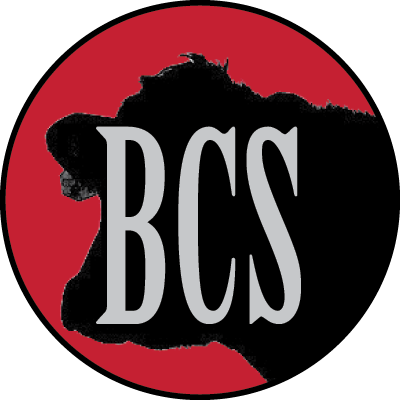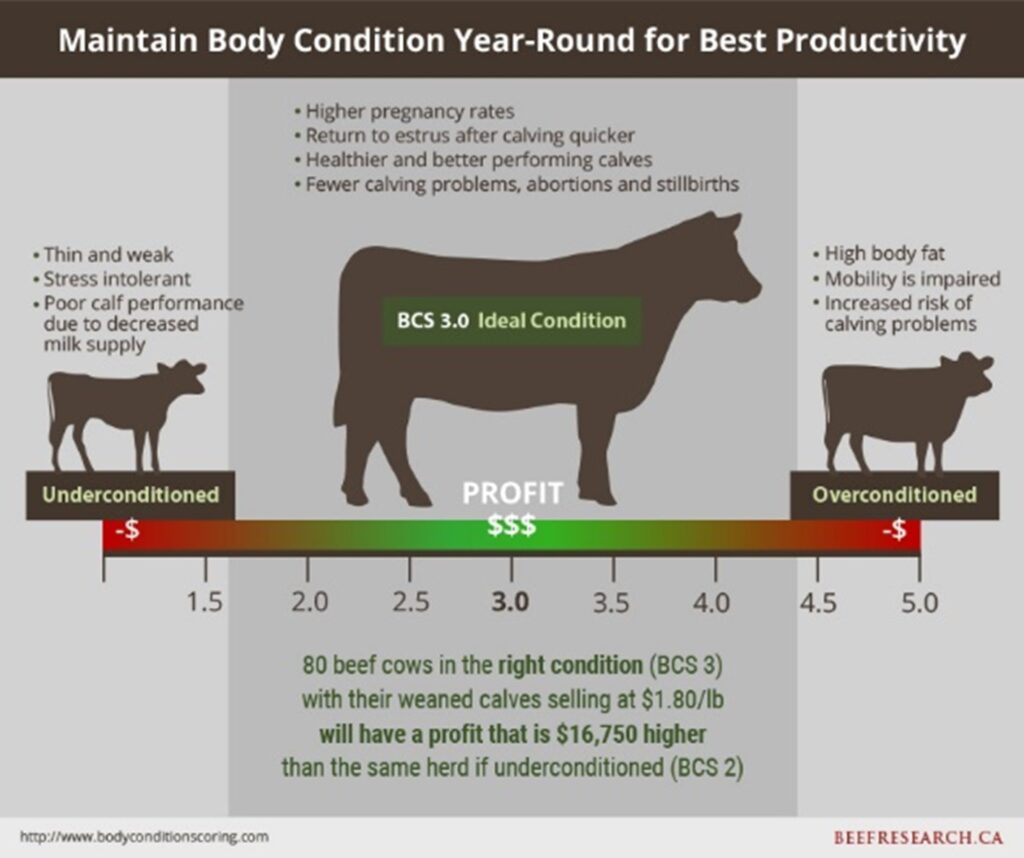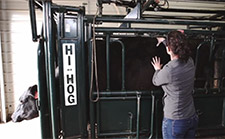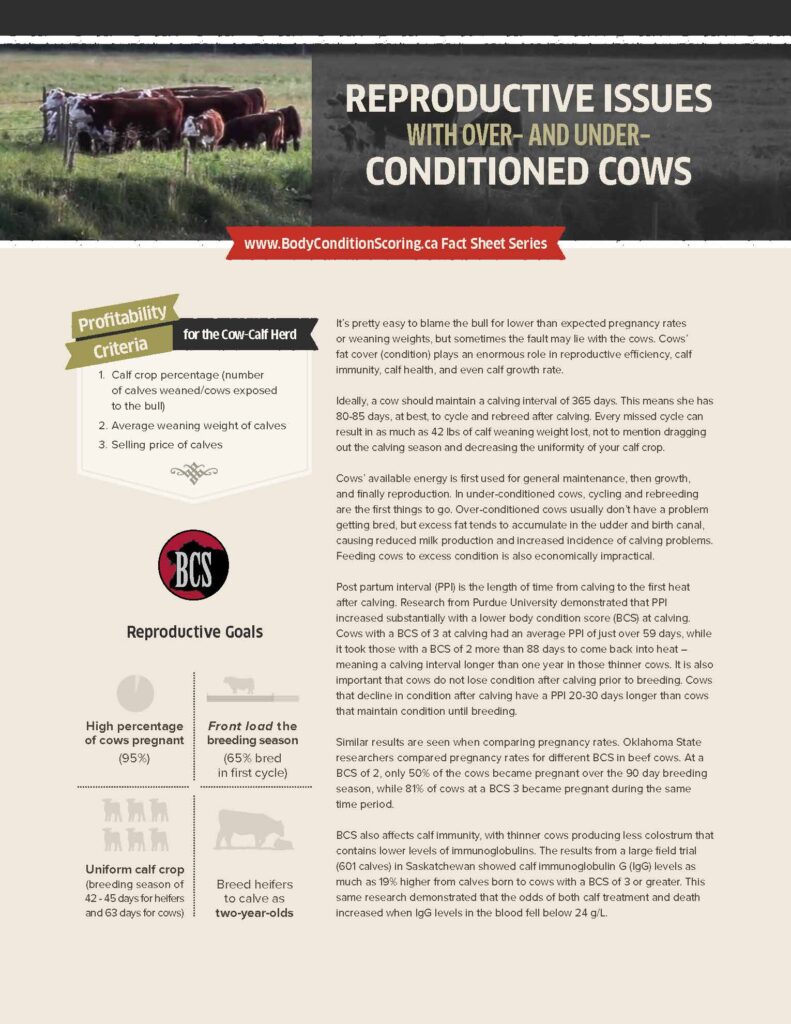Sections
- What is body condition scoring?
- How do I body condition score?
- Video
- Why is measuring body condition worthwhile?
- Interactive productivity and profitability tool
- Feed cost calculator
- When do I body condition score?
- What should I do if my animals are underconditioned?
- Considerations
- Downloads / Fact Sheets
- Learn More
- References

Optimum body condition = maximum production
The productivity of beef cows depends largely on the amount of fat they carry. A herd of cows maintained in the right condition with an ideal layer of fat cover will have more (and heavier) calves than a herd of thin or over-fat cows.
| Key Points |
| Body condition scoring is a hands-on method to determine the amount of condition that cattle have. |
| In Canada, body condition is scored from 1-5, with 1 being extremely thin and 5 being obese. A score of 3.0 is ideal. |
| When body condition scoring, feel for fat cover on cattle’s short ribs, spine, hooks, pins, and either side of the tail head. |
| Cows in ideal body condition have pregnancy rates double those of cows in poor condition, have improved milk production, fewer cases of abortion and stillbirth, healthier calves, and have fewer instances of calving problems. |
| One of the best times to body condition score is during fall processing or pregnancy checking. This will give you time to add condition on thinner cows before winter sets in. |
| If possible, cattle should be managed based on their age and body condition score. For example, during winter-feeding you may have groups that consist of mature cows in good condition, bred replacement heifers/2nd calvers, and thin and old cows. |
What is body condition scoring?
Body condition scoring is a low cost, hands-on method to determine the condition (amount of fat cover) cattle have. This easy hands-on method is much more accurate than just looking at the animals.
Looks can be deceiving, even to the trained and experienced eye. The shadows that help you see the body’s dips and hollows are harder to see on black cattle. The accuracy of visual evaluation also varies with the season. Prominent rib, hook and pin bones can be masked by long winter hair coats. Thin cows with round bellies full of straw can be mistaken as being in ideal condition when in fact they need improvement.

Research from the University of Guelph reported that even trained visual evaluators had a hard time accurately predicting the body condition score of cows in winter. The correlation between visual scores and ultrasonic backfat measurements was low (r2 = 0.14) in January to March. Cows in later stages of pregnancy may also appear to have more fat cover. A hands-on evaluation of the body condition score will give you a much better sense of your cows’ fat stores.
In Canada, body condition is scored from 1-5, with 1 being extremely thin and 5 being obese. A score of 3.0 is ideal.
How do I body condition score?
Feel for fat cover with your hands at:
- the short ribs
- the spine
- the hooks and pins
- either side of the tail head

An animal in ideal condition will have a thin layer of fat in these areas, so it will take some pressure to feel the bones.
An underconditioned animal’s bones will be quite prominent and sharp. In an obese animal, you won’t be able to feel any of the individual bones through the thick layer of fat.
See a demonstration in the video below.
Although the only true accurate way of body condition scoring is the hands-on method, telemedicine can be used by sending photos of videos to your vet to have them assess if a cow herd is holding their condition through the winter, after a body condition score was taken at pregnancy checking time for instance.
Why is measuring body condition worthwhile?
By having an accurate measure of your cows’ body condition, you’ll have a good indicator of how to manage their rations to maximize their productivity, especially reproduction.
Cows with an ideal body condition score (3.0) rebreed up to 30 days sooner than thin cows, which allows more cows to calve in the first 21-day cycle. This can add up to 42 lbs in calf weaning weight since the calves born earlier in the calving season will be heavier at weaning time. Cows in ideal body condition also have pregnancy rates double those of cows in poor condition, have improved milk production, fewer cases of abortion and stillbirth, healthier calves, and have fewer instances of calving problems.
The salvage value of cull cows in good condition is also higher. Very thin cows are more likely to experience negative outcomes during transport or to be condemned at the plant. Thin cows reflect poorly on the producer and the industry. It is important to note that thin cows are not always strictly related to nutrition. Several diseases such as Johne’s disease can be a contributing factor to thin cows.

Slide the bar below to see how body condition affects cows’ productivity and the value of their weaned calves.
This content was last reviewed November 2024.